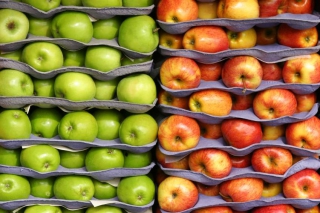
Crunching into Apple Season
30 September 2016A fall season favorite - apples – are falling off trees and into kitchen classrooms across the country. Consumers can expect more varieties with great health benefits.
Courtesy of the US Apple Association
Shorter days, colorful leaves and cooler temps mean fall is here. For many people, it’s also apple harvesting time. October is Apple Awareness month and the U.S. Apple Association is forecasting a stronger-than-average harvest this year.
“Apple season begins in August and continues into the early months of 2017 and we are predicting that apple lovers will find a healthy bounty of fresh apples this year,” said Wendy Brannen, USApple’s Director of Consumer Health & Public Relations. “With this year’s apple crop expected to be three percent above the five-year average, it will be a great time to enjoy your favorite varieties, plus explore new ones you’ve either wanted to try—or are just now seeing for the first time.”
Here are key facts about this year’s apple harvest:
- Apple growers expect to harvest 246 million bushels of apples
- That is almost 31 billion apples (as the average bushel holds 126 medium-sized apples)
- Each apple will be hand-picked by people using ladders and cloth buckets – most will be picked between late August and end of October
- While apples are grown in each of the lower 48, most apples will come from Washington, New York, Michigan, Pennsylvania and Virginia
- More than 7,500 growers manage orchards covering 322,000 acres – most are independent, family-owned
- Approximately 200 varieties will be grown, but 80 percent of all production will be from 10 varieties
- Approximately 33 percent of the harvest will be processed into apple juice, applesauce, frozen and other products
As the Saying Goes...
The health benefits of apples and apple products were first recorded as early as medieval times, giving rise to the old English saying, “Ate an apfel avore gwain to bed makes the doctor beg his bread” and its modern day variation, “An apple a day keeps the doctor away.”
Apple: The Superfruit
Recent studies have found that apples and apple products help in a variety of health areas from assisting in weight loss to deterring different types of cancer, heart disease and type 2 diabetes.
Other studies recently completed have linked apples and apple products with improving the symptoms of Alzheimer´s disease and possibly decreasing the risk for developing it as well as improved immunity and gut health due to the pectin (soluble fiber) found in the apple’s peel.
Did You Know This About Apples?
- The crabapple is North America’s only native variety.
- Apples are a member of the rose family.
- Apple trees take four to five years to produce their first fruit.
- It takes about 36 apples to create one gallon of apple cider.
- Apple varieties range in size from a little larger than a cherry to as large as a grapefruit.
- Apples ripen six to 10 times faster at room temperature than if they are refrigerated.
- More than 7,500 growers manage 325,000 acres of apple orchards, trailing only oranges and grapes in the amount of U.S. acreage committed to fruit production.
The most-purchased fresh apple varieties are (in order): gala, red delicious, fuji, granny smith, honeycrisp, golden delicious, McIntosh, pink lady, braeburn, and ambrosia.
About US Apple
U.S. Apple Association is the national trade association representing all segments of the apple industry. Members include 40 state and regional associations representing the 7,500 apple growers throughout the country, as well as more than 400 individual firms involved in the apple business. More information on the organization is available at USApple.org.
